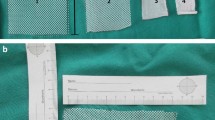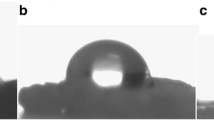Abstract
For the first time, by scanning electron microscopy (SEM), polypropylene (PP) excised meshes (ethylene oxide sterilized) for abdominal wall hernia repair have been shown to be greatly damaged physically, independently of the implantation time, while the polyethylene terephthalate (PET), or Dacron, ones (gamma radiation sterilized), did not undergo alterations due to the sterilization process and were not damaged, even after long implantation periods. Fourier-Transform Infrared Spectroscopy (FTIR) study of PP and PET excised meshes, as well as of their extracts with cyclohexane, has shown the presence of species, such as squalene, palmitic and stearic acid, in some cases, cholesterol, transferred from the surrounding tissues to the polymer during the implantation period. In the case of PP meshes, these small organic molecules would reduce physical and mechanical properties of the material. A hypothesis is presented to account for the better behavior (not in the clinical sense) of PET meshes.







Similar content being viewed by others
References
Debord JR (2001) Prostheses in hernia surgery: a century of evolution. In: Bendavid R (ed) Abdominal Wall Hernias. Springer, New York, pp 16–32
Klinge U, Klosterhalfen B, Muller M, Ottinger AP, Schumpelick V (1998) Shrinking of polypropylene mesh in vivo: an experimental study in dogs. Eur J Surg 164:965–969
Amid PK (1997) Classification of biomaterials and their related complications in abdominal wall hernia surgery. Hernia 1:15–21
Coda A, Bendavid R, Botto-Micca F, Bossotti M, Bona A (2003) Structural alterations of prosthetic meshes in humans. Hernia 7:29–34
Costa L, Luda MP, Trossarelli L, Brach del Prever EM, Crova M, Gallinaro P (1998) Oxidation in orthopaedic UHMWPE sterilized by gamma-radiation and ethylene oxide. Biomaterials 19:659–668
Baccaro S, Brunella V, Cecilia A, Costa L (2003) Gamma irradiation of Poly(Vinyl Chloride) for medical applications. Nucl Instrum Methods Phys Res B: Beam Interact Mater Atoms 208:195–198
Costa L, Luda MP, Trossarelli L, Brach del Prever EM, Crova M, Gallinaro P (1998) In vivo UHMWPE biodegradation of retrieved prosthesis. Biomaterials 39:1371–1386
Clegg DW, Collyer AA (1991) Irradiation effects on Polymers, Elsevier Applied Science, New York
Maarek JM, Guidoin R, Aubin M, Prud’homme RE (1984) Molecular weight characterization of virgin and explanted polyester artherial prostheses. J Biomed Mater Res 18:881–894
Vinard E, Eloy R, Descotes J, Brudon JR, Guidicelli H, Magne JL, Patra P, Berruet R, Huc A, Chauchard J (1988) Stability of performances of vascular protheses retrospective study of 22 cases of human implanted prosteses. J Biomed Mater Res 22:633–648
Morris-Stiff GJ, Hughes LE (1998) The outcomes of nonabsorbable mesh placed within the abdominal cavity: literature review and clinical experience. J Am Coll Surg 186:352–367
Coda A, Botto-Micca F, Quaglino F, Ramellini G (2000) In vivo tissue reaction to different prosthetic materials in abdominal wall hernia repair. Hernia 4:206–211
Lin-Vien D, Colthup NB, Fateley WG, Grasselli JG (1991) Handbook of infrared and Raman characteristic frequencies of organic molecules. Academic Press, San Diego
Leardini G, Ramonda R (1996) Physical and chemical features of the synovial fluid. Reumatismo 48:43–51
Costa L, Bracco P, Brach del Prever EM, Luda MP, Trossarelli L (2001) Analysis of products diffused into UHMWPE prosthetic components in vivo. Biomaterials 22:307–315
Mark HF (1965) Polymers in material science. J Polym Sci C 9:1–33
Author information
Authors and Affiliations
Corresponding author
Rights and permissions
About this article
Cite this article
Bracco, P., Brunella, V., Trossarelli, L. et al. Comparison of polypropylene and polyethylene terephthalate (Dacron) meshes for abdominal wall hernia repair: A chemical and morphological study. Hernia 9, 51–55 (2005). https://doi.org/10.1007/s10029-004-0281-y
Received:
Accepted:
Published:
Issue Date:
DOI: https://doi.org/10.1007/s10029-004-0281-y




